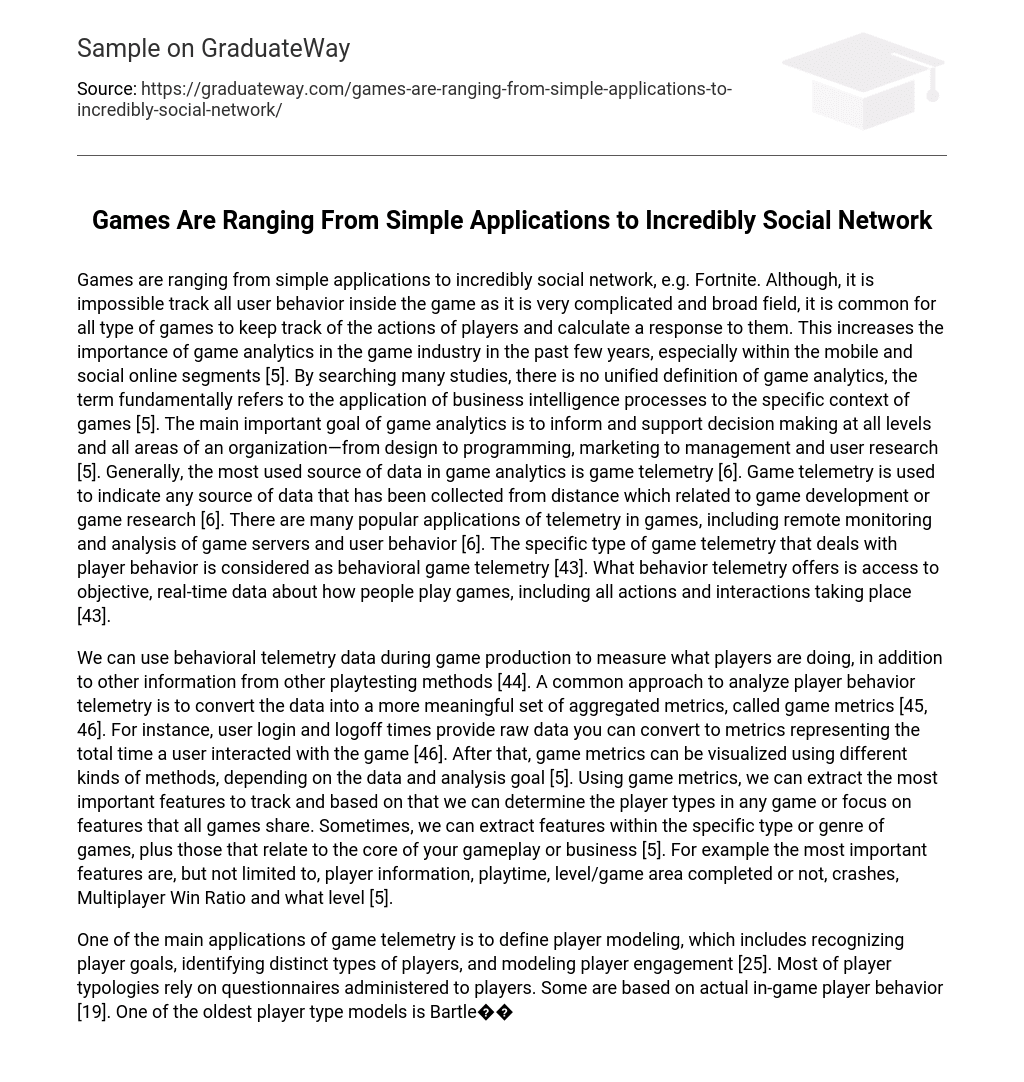Games are ranging from simple applications to incredibly social network, e.g. Fortnite. Although, it is impossible track all user behavior inside the game as it is very complicated and broad field, it is common for all type of games to keep track of the actions of players and calculate a response to them. This increases the importance of game analytics in the game industry in the past few years, especially within the mobile and social online segments [5]. By searching many studies, there is no unified definition of game analytics, the term fundamentally refers to the application of business intelligence processes to the specific context of games [5]. The main important goal of game analytics is to inform and support decision making at all levels and all areas of an organization—from design to programming, marketing to management and user research [5]. Generally, the most used source of data in game analytics is game telemetry [6]. Game telemetry is used to indicate any source of data that has been collected from distance which related to game development or game research [6]. There are many popular applications of telemetry in games, including remote monitoring and analysis of game servers and user behavior [6]. The specific type of game telemetry that deals with player behavior is considered as behavioral game telemetry [43]. What behavior telemetry offers is access to objective, real-time data about how people play games, including all actions and interactions taking place [43].
We can use behavioral telemetry data during game production to measure what players are doing, in addition to other information from other playtesting methods [44]. A common approach to analyze player behavior telemetry is to convert the data into a more meaningful set of aggregated metrics, called game metrics [45, 46]. For instance, user login and logoff times provide raw data you can convert to metrics representing the total time a user interacted with the game [46]. After that, game metrics can be visualized using different kinds of methods, depending on the data and analysis goal [5]. Using game metrics, we can extract the most important features to track and based on that we can determine the player types in any game or focus on features that all games share. Sometimes, we can extract features within the specific type or genre of games, plus those that relate to the core of your gameplay or business [5]. For example the most important features are, but not limited to, player information, playtime, level/game area completed or not, crashes, Multiplayer Win Ratio and what level [5].
One of the main applications of game telemetry is to define player modeling, which includes recognizing player goals, identifying distinct types of players, and modeling player engagement [25]. Most of player typologies rely on questionnaires administered to players. Some are based on actual in-game player behavior [19]. One of the oldest player type models is Bartle’s player types [8]. He studied what players desired from multi-user dungeons (MUDs) based on a discussion between dozens of senior players, he identified four player types on two axes that express the player’s desire to interact with or act on the virtual world or other players: achievers who is acting on the world, explorers who is interacting with the world, socializers who is interacting with other players, and killers who prefer to act on other players [8].
Bartle later extended the model by adding a third dimension [9]: implicit or explicit (i.e., whether the player actions are automatic and unconscious or considered and planned). Bartle’s model is has been used by many researchers especially by gamification practitioners because of its simplicity [7]. However, it was never empirically validated nor was it intended to be used outside of the domain of MUDs [7]. Yee [10, 12] identified three main components of player motivation with ten sub-components which were based on a factor analysis of questions inspired by the original Bartle’s player types: achievement (advancement, mechanics, competition), social (socializing, relationship, teamwork), and immersion (discovery, roleplaying, customization, escapism) [10, 12]. Recently, Yee [11] expanded his previous work by conducting a factor analysis on over 140,000 participants and developed a ‘gamer motivation profile’ and identified 12 dimensions grouped into 6 clusters: action (destruction and excitement), social (competition and community), mastery (challenge and strategy), achievement (competition and power), immersion (fantasy and story), and creativity (design and discovery). This recent proprietary investigation intended to capture player motivations towards many different games and was empirically supported by factor analysis [11].
However, a standard assessment tool is not publicly and readily available [7]. Another player type’s model made by BrainHex when he built his player typology based on two models of demographic game design. BrainHex [47, 50] is a top-down player typology, that has ( delete and keep reference to use takes inspiration from neurobiological player satisfaction research[48], previous typology approaches, discussions of patterns of play, and the literature on game emotions to builds even archetypes denoting distinct experiences of play.) seven archetypes (and their associated player motivations) which are: achiever (completion), conqueror (challenge), daredevil (excitement and risk), mastermind (strategic reasoning), seeker (exploration and curiosity), socialiser (social interactions), and survival (frightening experiences) [47,50] . BrainHex extended existing research with a diverse array of player types. However, initial empirical investigation on its psychometric properties has shown low reliability scores [49]. Finally, Marczewski [51] built on the literature about player types and self-determination theory in games [52, 53] to create the user types HEXAD model, which classifies distinct user preferences. The six HEXAD user types (and the motivation they represent) are: philanthropist (altruism), socializer (relatedness), free spirit (autonomy), achiever (competence), player (rewards), and disruptor (change) [52,53].





